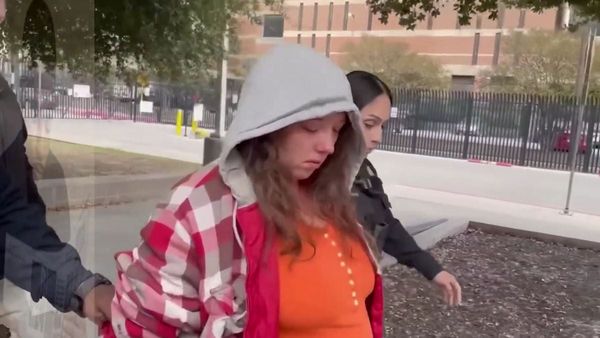
Martin Scorsese’s western true-crime thriller is about the US’s Osage murders of the early 1920s, based on the nonfiction bestseller by David Grann. With co-writer Eric Roth, Scorsese crafts an epic of creeping, existential horror about the birth of the American century, a macabre tale of quasi-genocidal serial killings which mimic the larger erasure of Native Americans from the US. It places in the drama’s foreground a gaslit marriage of lies and poisoned love. It echoes Scorsese’s earlier work about mob violence, mob loyalty and the final, inevitable sellout to the federal authorities, whose own bad faith gradually emerges. But in the end, this film is about what all westerns are about, and perhaps all history: the brutal grab for land, resources and power.
Lily Gladstone gives a performance of tragic force as Mollie Burkhart, a Native American woman from the Osage tribe who, like all her people, has become unexpectedly wealthy because the apparently stony and unpromising land in Oklahoma on which the authorities allowed the Osage to settle turned out to have huge reserves of oil. But they are still subject to a racist and infantilising condition of “guardianship”: to claim the income and spend it, Osage individuals need a white co-signatory. And there is something else: Mollie and her family are deeply disturbed by mysterious illnesses which have been killing off Osage people, one by one. Later the bodies of Osage murder-victims are found, including Mollie’s wayward sister Anna (Cara Jade Myers), whose autopsy is bizarrely carried out in the open air, at the crime scene itself.
Into this situation arrives a slippery, venal individual called Ernest, played by Leonardo DiCaprio; an ambitious but also submissive and fundamentally inadequate man: greedy, stupid and biddable. He has returned to the US after service in the first world war, and comes to the vast estate of his wealthy uncle, who has offered him a job working alongside his hardfaced brother Bryan (pronounced “By-ran”), played by Scott Shepherd, who has clearly been extensively normalised in the violence and corruption over which the uncle presides.

This cattleman-plutocrat is William Hale, played by Robert De Niro, a man of calcified resentment and self-importance who preens himself on his good relations with the Osage people. Hale hires Ernest for a position as his vague underling, courtier and dirty-work factotum, and encourages him to date and also marry Mollie, whom Ernest has already met, which would give him (and therefore Hale) a legal claim on Mollie’s “headrights”, as her oil entitlements are known. And so Ernest and Mollie’s doomed marriage commences, complicated by the terrible fears of Mollie’s ailing mother, Lizzie Q (Tantoo Cardinal), who has a quietly beautiful death scene. Mollie’s diabetes is also a factor; it is made strangely worse by the medicine Hale has procured for her, and which Ernest administers while always simpering and blubbing his concern for her declining health.
When the situation becomes too bad for the federal authorities to ignore, Washington DC sends an officer of its fledgling Bureau of Investigations (later to be the FBI). This is Tom White, played by Jesse Plemons. But Scorsese shows us the politics: the bureau’s belated appearance appears to be, at least partly, a matter of containing the difficult situation involving the white people and the inescapably wealthy Osage peoples, and reinforcing federal control over the new state of Oklahoma.
As performed by Gladstone and DiCaprio, the relationship between Mollie and Ernest has a kind of spiritual nausea; Ernest is sincere about his feelings for his wife, in his way, but they are part of a context of bad faith and violence. His real relationship is of course with his uncle, he is the beta to the older man’s alpha. Weirdly, DiCaprio starts to look like DeNiro, like a dog resembling its master: a younger, victim-villain version with the same gimlet-eyed fear and hostility and the same rat-trap mouth with the corners turned down. His uncle has inducted him into the Masons, and it is into the local masonic hall, with all its regalia, that Hale leads the wretched Ernest for a corporal punishment scene when the young man lets him down – the most extraordinary corporal punishment I have seen since Lindsay Anderson’s If….
Hale’s rule, so avowedly caring and sensitive to the Osage, is in fact creating a vast dysfunction of depression, alcoholism, lawlessness, fatal illness and murder. Gladstone creates a persona for Mollie that is flawed and self-reproachful, with some shame at having collaborated with her persecutor. She has dignity and calm and rises above the squalor all around her, but that calm is also the stricken immobility of illness. And she knows that Ernest was never any good but she was charmed and seduced by him all the same.
Scorsese presents a remarkable story, with an audacious framing device of a briskly insensitive “true crime” radio show featuring Osage characters crassly played by white actors. This is an utterly absorbing film, a story that Scorsese sees as a secret history of American power, a hidden violence epidemic polluting the water table of humanity.
• Killers of the Flower Moon screened at the Cannes film festival.







